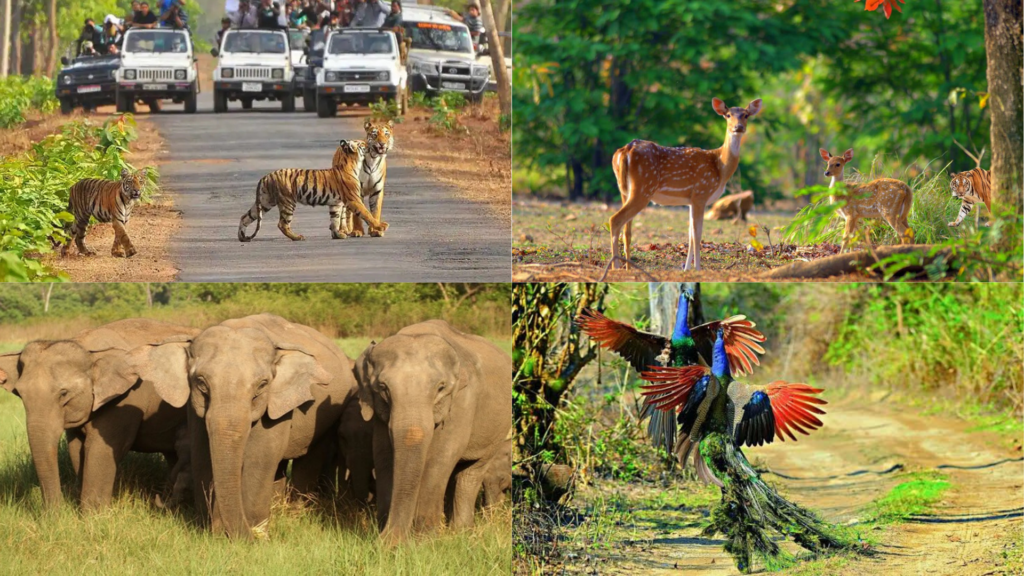Jim Corbett National Park, nestled in the foothills of the Himalayas in Uttarakhand, is one of India’s most famous wildlife destinations. Known for its diverse flora, fauna, and picturesque landscapes, this park attracts nature enthusiasts, wildlife photographers, and adventure seekers year-round. However, the best time to visit Jim Corbett depends on what you wish to experience. Here’s a seasonal guide to help you plan your trip effectively.

Seasons in Jim Corbett National Park
1. Winter (October to February)
Best for: Wildlife Safaris and Bird Watching
Winters are the ideal time to visit Jim Corbett, with temperatures ranging between 5°C to 20°C. The crisp air, clear skies, and cool weather make it perfect for safaris. The park’s flora is less dense during this time, improving visibility and increasing the chances of spotting tigers, elephants, and other wildlife.
Additionally, winter is a paradise for birdwatchers as migratory birds flock to the park. The riverbanks and marshlands come alive with the sights and sounds of diverse avian species.
Why visit in winter?
- Tiger sightings are common due to their movement in search of warmth.
- Great for photography with clear lighting and scenic views.
- Ideal weather for outdoor activities like jungle safaris.
2. Summer (March to June)
Best for: Tiger Spotting
Summers in Jim Corbett can get hot, with temperatures reaching up to 40°C. Despite the heat, summer is one of the best times to visit for wildlife enthusiasts. During this season, animals often come out in search of water and gather around rivers and waterholes, increasing the chances of sightings.
Early morning and late evening safaris are the best options to avoid the scorching heat while maximizing your wildlife-spotting opportunities.
Why visit in summer?
- High chances of spotting tigers and elephants near water sources.
- The Dhikala zone is fully open, offering premium wildlife experiences.
- Lesser tourist crowds, leading to a more peaceful visit.
3. Monsoon (July to September)
Best for: Nature Lovers and Budget Travelers
The monsoon season brings lush greenery and a rejuvenated landscape to Jim Corbett. While many zones of the park remain closed during this period for safety reasons, the Jhirna zone is open for visitors. The park becomes a haven of tranquility as the rainfall breathes new life into its flora and fauna.
Although wildlife spotting might be more challenging, the monsoon is ideal for those looking to enjoy the scenic beauty of the region. This is also an excellent time for budget travelers as accommodation and safari prices tend to drop.
Why visit in monsoon?
- Witness the lush greenery and refreshing landscapes.
- Great time for nature walks and exploring the park’s periphery.
- Fewer tourists, ensuring a quieter experience.
Zones to Visit in Jim Corbett
Jim Corbett National Park is divided into several tourism zones, each offering unique experiences. Here’s a quick guide to the zones and their seasonal accessibility:
- Dhikala Zone: Best in winter and summer for tiger sightings.
- Bijrani Zone: Open from October to June; excellent for safaris.
- Jhirna Zone: Open year-round, ideal for monsoon visitors.
- Durga Devi Zone: Great for birdwatching, open from November to June.
- Garjiya Zone: Known for its scenic beauty, open from October to June.
Pro Tips for Visiting Jim Corbett National Park
- Book Safaris in Advance: Safari slots fill up quickly, especially in peak seasons, so make your bookings early.
- Choose the Right Zone: Research the zones based on your interests, such as wildlife spotting or birdwatching.
- Wear Appropriate Clothing: Neutral-colored clothes are ideal for blending into the surroundings. Carry warm layers in winter and lightweight clothing in summer.
- Follow Guidelines: Respect the park rules, maintain silence during safaris, and avoid feeding or disturbing wildlife.
Conclusion
The best time to visit Jim Corbett National Park depends on what you want to experience. Winter and summer are excellent for wildlife spotting, while monsoons offer a serene escape into nature. Each season has its own charm, making the park a year-round destination for nature lovers.
